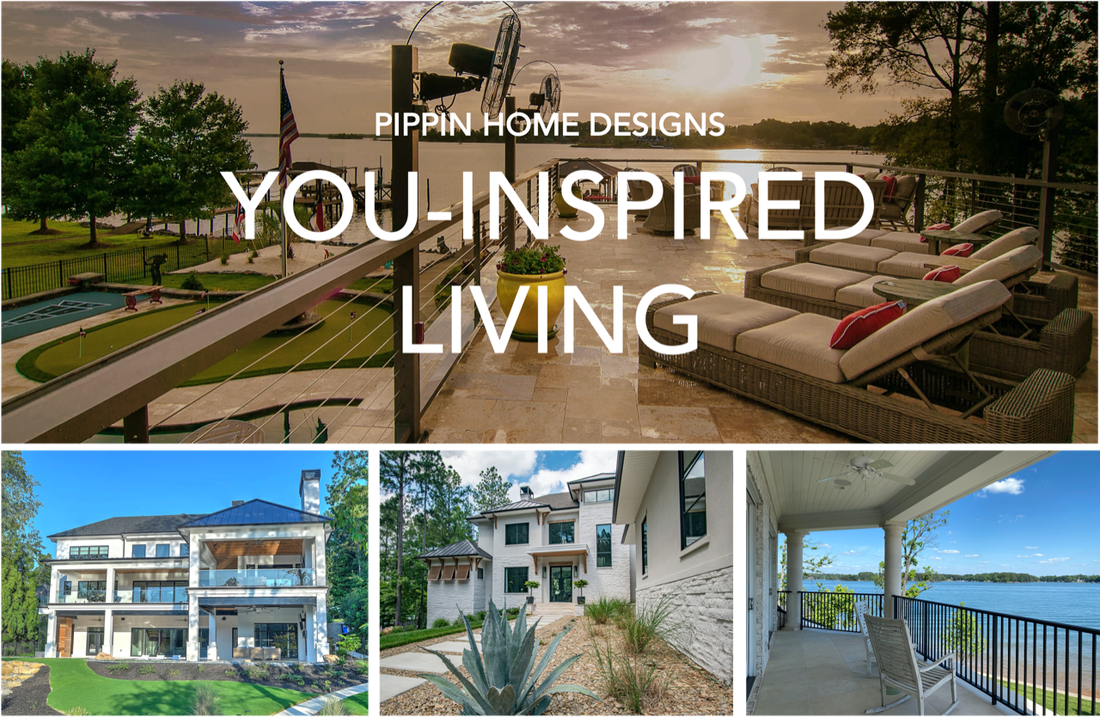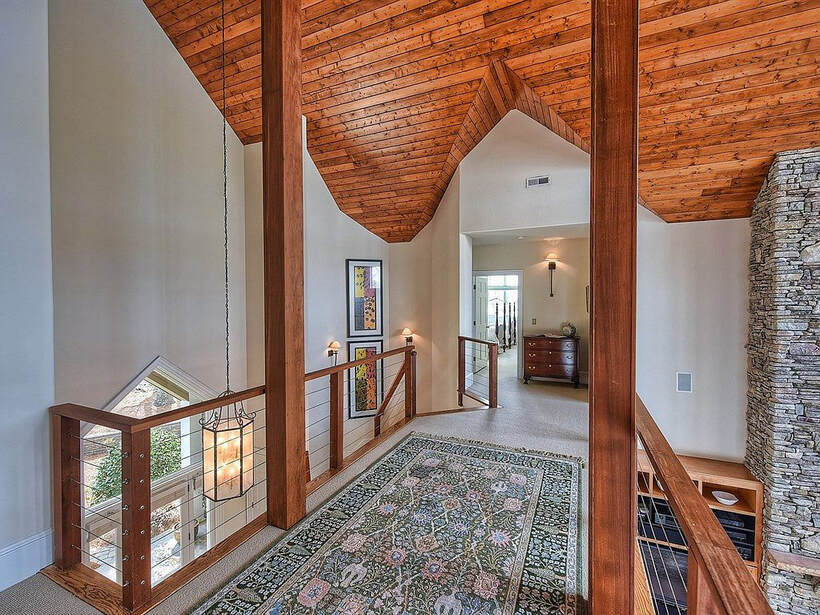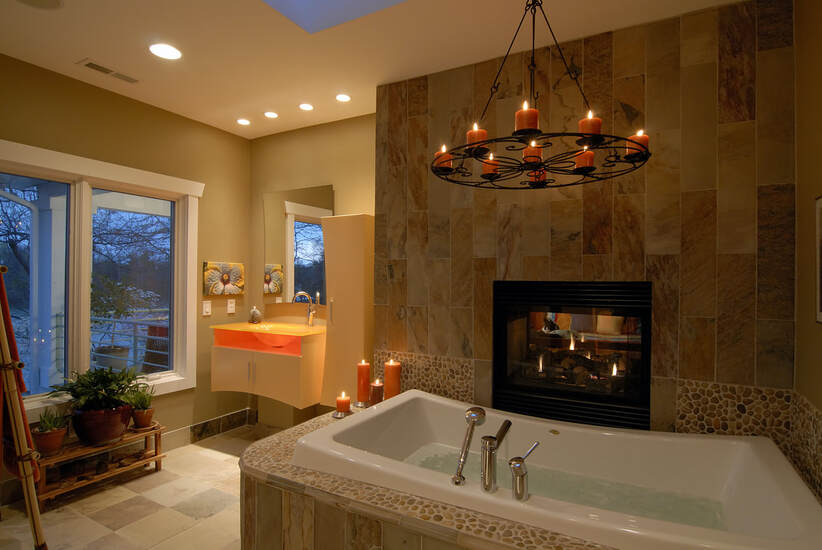
 Photo credit: James Russell Architect Photo credit: James Russell Architect The word biophilia is the combination of two Greek words: “life” (bio) and “love” (philia). It literally translates to love of life. This love of life is an inherent personality trait that ALL humans possess as a result of evolutionary biology and psychology. Biophilia has played an integral role in the success of humanity beyond just survival. We THRIVE in nurturing natural environments. Wise designers are harnessing the power of biophilia and using our love of life to create healthier happier homes by using biophilic design techniques to bring more of the outdoors inside, which in turn translates into a deeper love of your home. In this 10th post of the Happy by Design series, I explain what biophilic design is, how it functions to foster happiness, and how to work with the alchemical elements of water, air, earth, and fire to incorporate biophilic design in your home. Biophilic Design’s Impact on Happiness The term biophilia was coined in 1964 by German psychologist Erich Fromm to describe the human’s psychological attraction to all that is alive and vital. Twenty years later, American biologist E.O. Wilson used the term biophilia to describe how evolutionary adaptation allowed us to develop a physiological link with the living world and nature. In 1993, Wilson and Stephen R. Kellert published The Biophilia Hypothesis that explains the human dependency on nature “extends far beyond the simple issues of material and physical sustenance to encompass, as well, the human craving for aesthetic, intellectual, cognitive, and even spiritual meaning and satisfaction.” We are connected to and dependent on nature for our survival and happiness. In our blog Beauty: It’s Not Just in the Eye of the Beholder we point out that your need to experience beauty is encoded in your DNA. Neuroscience explains that humans have become adapted to recognize patterns and shapes in nature as beautiful because they cause the autonomic nervous system to trigger sensations of peace, calm, awe, and a connection to the world around us. However, not all natural environments are nurturing and supportive of human existence. Deep sea habitats, barren desert, alien or extinct species, or other obscure elements of nature that have no bearing on human health offer little to no benefit in terms of biophilic design. Biophilic design focuses on the natural elements that have contributed to human health, happiness, and productivity. Research has shown that exposure to nurturing natural habitats can lower stress, elevate your mood, make you feel more relaxed, and improve cognitive functions. A home designed with biophilia in mind results in a beautifully built environment that helps you live in alignment with your instinctual need to cohabitate with nature. The core natural elements of water, air, earth, and fire are used in biophilic design. Water – Ever Flowing Emotional Wellness Few things are as supportive to human existence as water. Known health and wellbeing benefits associated with access to water include reduced stress, lowered heart rate and blood pressure, increased feelings of tranquility, positive emotional responsiveness, improved concentration and perception, and memory restoration. This explains why many people gravitate to living on a lake or beach front property. The sounds of running water help increase concentration and support relaxation. Small fountains or water walls can be used as a sound barrier in areas of the home needing more privacy. A home office, living room, or entry of the home are great places for small water features. Large water features should be placed in areas where the maximum number of people can enjoy them for a prolonged period of time, such as a covered porch or sitting room. Integrating aesthetic water features into a home’s water management plan allows you to capture and enjoy the benefits of rain or ground water. Design ponds in areas with a high water table and use rain chains that lead rainwater into a rain collection barrel. Fish tanks, artwork, and photography of water images are beautiful ways to add the water element to your home. Textiles, ceramic tiles, or objects with wavy patterns can amplify the happy benefits of water throughout your home. Air - Cohesive Flow & Connection In the natural world, air is constantly moving. Cool breezes, warm gusts of wind, weather systems, and pressure zones are all part of the dance between the earth and the atmosphere. Indoor air tends to be much more stagnant and prone to contamination. If the air inside your home is not flowing, it’s not being treated, and stagnant untreated air leads to health issues. The main goal of biophilic design is to make interiors healthier and health cannot be achieved without clean air. Excellent indoor air quality is only attained when designed for properly and involves far more than you may realize. Check out our blog Your Secret Weapon Against Indoor Air Issues to learn more about designing for exceptional indoor air quality. Other biophilic design techniques for working with the air element include designing a cohesive flow from room to room and space to space. Open floor plans can create an airy and expansive feeling within your home. Strategic placement and use of operable windows let in fresh air while providing views that make your space appear larger and feel more connected to nature. Earth – Substrate for Bliss Without the earth we would have nothing to call home. Wood and stone have been the substrate on which to build our lives, the materials to build our homes, and the tools used to advance our status amongst other living organisms. Wood has been found to have many positive psychological and physiological benefits including:
Wood, specifically with visible wood grain, can be used to mimic the stress-reducing sensations inspired by a forest. Imagine the benefits of forest bathing while inside your own home! Using wooden beams on a ceiling can create the impression of a tree canopy, producing feelings of shelter, warmth, and protection. In a natural forest there are breaks between trees and so using visible wood grain as an accent or trim on the walls helps mimic similar visual breaks. Using plants amongst wood accents to further create forest-like visual breaks enhances biophilia sensations. Stay tuned for our next blog that expands on plant use and biomorphic patterns in biophilic design. Using reclaimed wood throughout your home in flooring, paneling, tables, and stairs is a great way to incorporate sustainable materials that also boost biophilic benefits. Natural stone is another earth element that lends to effective biophilic design. Think about how many different natural materials make up a landscape from the ground to the tops of the trees. Just like in nature, various materials should be used to create a cohesive biophilic home. Stone can be used for walls, showers, seating areas, hearths, chimneys, columns, and planters as beautiful focal points that take center stage. As the eye moves to these areas that stand out, the brain receives the same soothing, stress reducing sensations created by the variety and abundance offered by nature. Fire – The Spark of Evolution The control of fire by early humans led to significant evolutionary advances. Fire provided warmth and lighting, protection from predators, and a method for cooking which led to the surge in human brain size and intelligence. The nurturing aspects of fire can be incorporated with the design of fireplaces that create a warm and cozy environment. The meditative effects of staring into a fire helps shift from a sympathetic nervous system/fight or flight response into a parasympathetic/rest and digest state. A fireplace also creates a social environment for people to gather and connect to one another. Designing your home to work with the sun - the ball of fire in the sky that’s keeping us all alive - is an essential element of biophilic design. The placement of your home on your property must consider the movement of the sun across your lot when designing for maximized natural daylighting and sun exposure. The many health and happiness benefits of sunlight include stress and anxiety reduction, mood enhancement, blood pressure reduction, immune system improvement, and circadian rhythm regulation. Learn more in our blog Natural Daylighting Strategies: Improving the Value of Your Home & Your Life. Strategic placement of windows, overhangs, and porches will aid in the enhancement of natural lighting in your home that also maintains comfortable temperatures while maximizing views. Incandescent lighting is another way to mimic the beneficial light emitted from a fire. The warm glow of an incandescent lamp is produced by the heating of a filament inside the bulb. Incandescence, aka light emitted by heat, is the same technology used by fire and the sun. Learn more about the health benefits of incandescent lights in our blog Earth-Centric vs Human-Centric Light Bulbs: When Lighting is Designed Without Health in Mind. Healthy Happy Habitats The fundamental goal of biophilic design is to create healthy happy built habitats for humans, recognizing that people are biological organisms that can only thrive in relation to other biological organisms. Successful biophilic design involves so much more than the simple inclusion of a few natural materials. Effective biophilic design integrates the elements of nature to create coherence, connection, and a flow that is sensed as you move throughout your home, inside and out. Stay tuned for our next blog that expands on the power of biophilic design to heal mind, body, and soul. I intend your love of life is expressed every day in a home designed to enhance your happiness. Jenny Pippin, CPBD, FAIBD, CGP
Pippin Home Designs
0 Comments
Leave a Reply. |
AuthorI am Jenny Pippin, founder of Pippin Home Designs and creator of my own inspired living. I grew up as an ordinary southern girl, working in the fields of my family’s tobacco farm. It didn’t take me long to realize I had greater gifts and so I chose to step into my power and create my own path in life, inspired by my heart’s true passion. (More on my personal story HERE!) Archives
February 2024
Categories
All
|
Copyright 2020. Pippin Home Designs. All rights reserved.
ARCHITECTURAL DESIGN COPYRIGHT NOTICE
1987-2024 Copyright. Jennifer B. Pippin FAIBD, CPBD. Pertaining to all home designs, drawings, and photographic imagery of completed designs
presented herein. No part of the contents of the design work presented on this website may be reproduced or transmitted in any form or
by any means, electronic or mechanical, for the purpose of replication or adaptation. This material is intended to provide accurate and
authoritative information about the design abilities and expertise of Jennifer B. Pippin FAIBD, CPBD and Pippin Home Designs.
ARCHITECTURAL DESIGN COPYRIGHT NOTICE
1987-2024 Copyright. Jennifer B. Pippin FAIBD, CPBD. Pertaining to all home designs, drawings, and photographic imagery of completed designs
presented herein. No part of the contents of the design work presented on this website may be reproduced or transmitted in any form or
by any means, electronic or mechanical, for the purpose of replication or adaptation. This material is intended to provide accurate and
authoritative information about the design abilities and expertise of Jennifer B. Pippin FAIBD, CPBD and Pippin Home Designs.










 RSS Feed
RSS Feed
